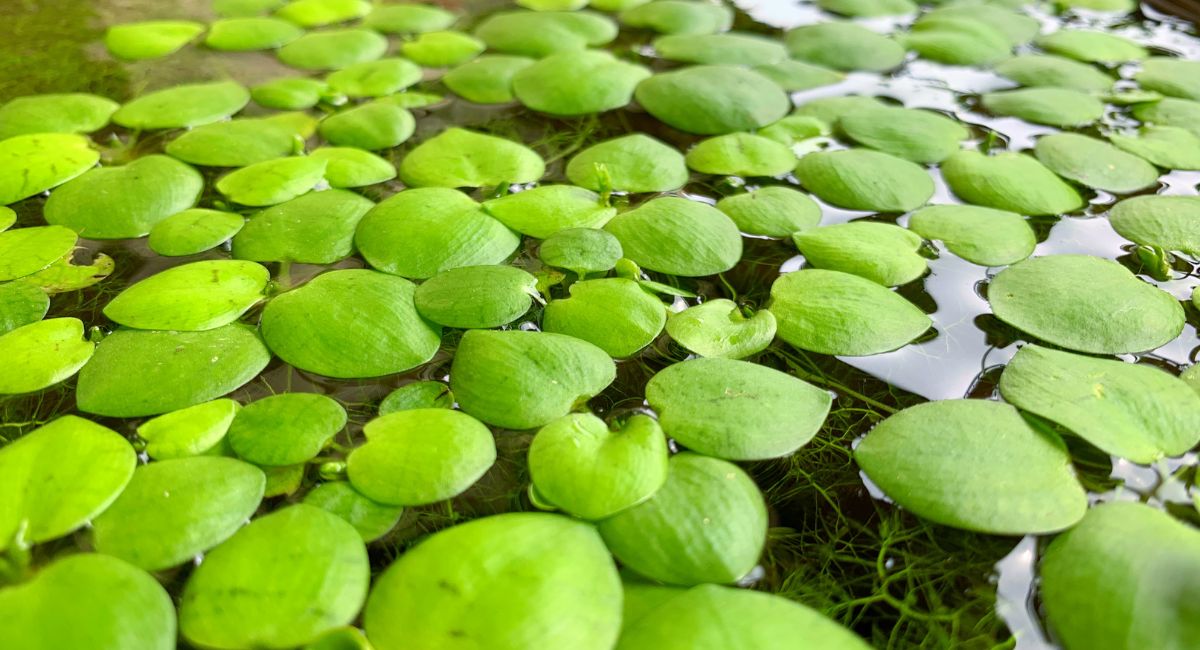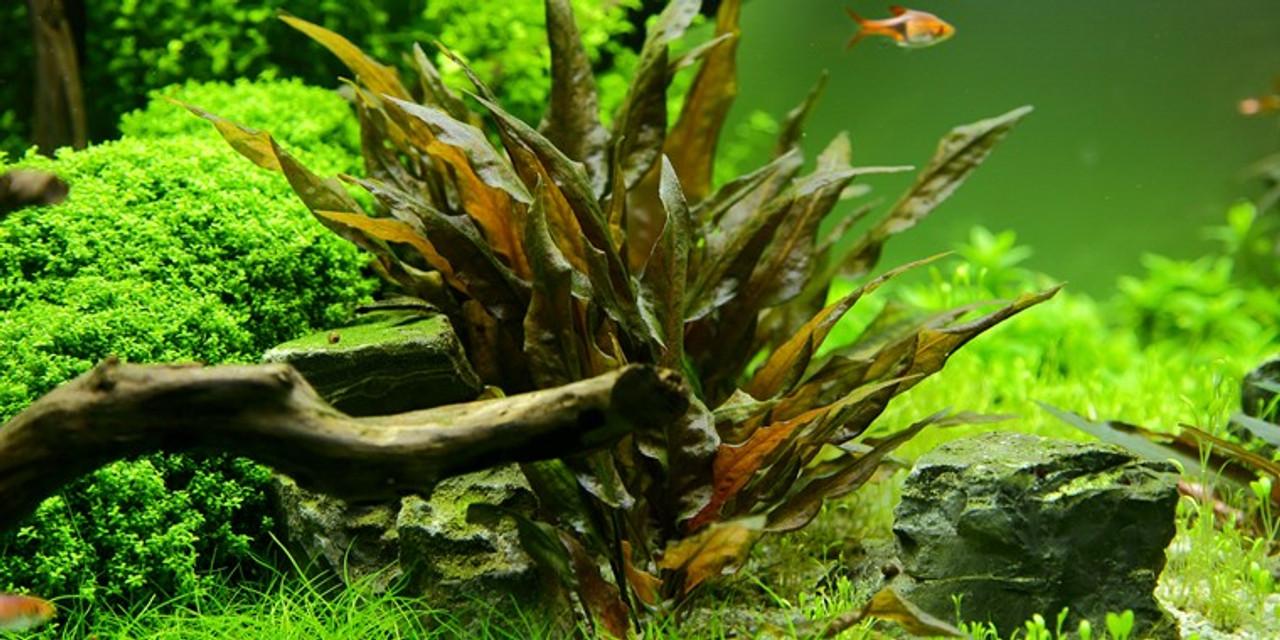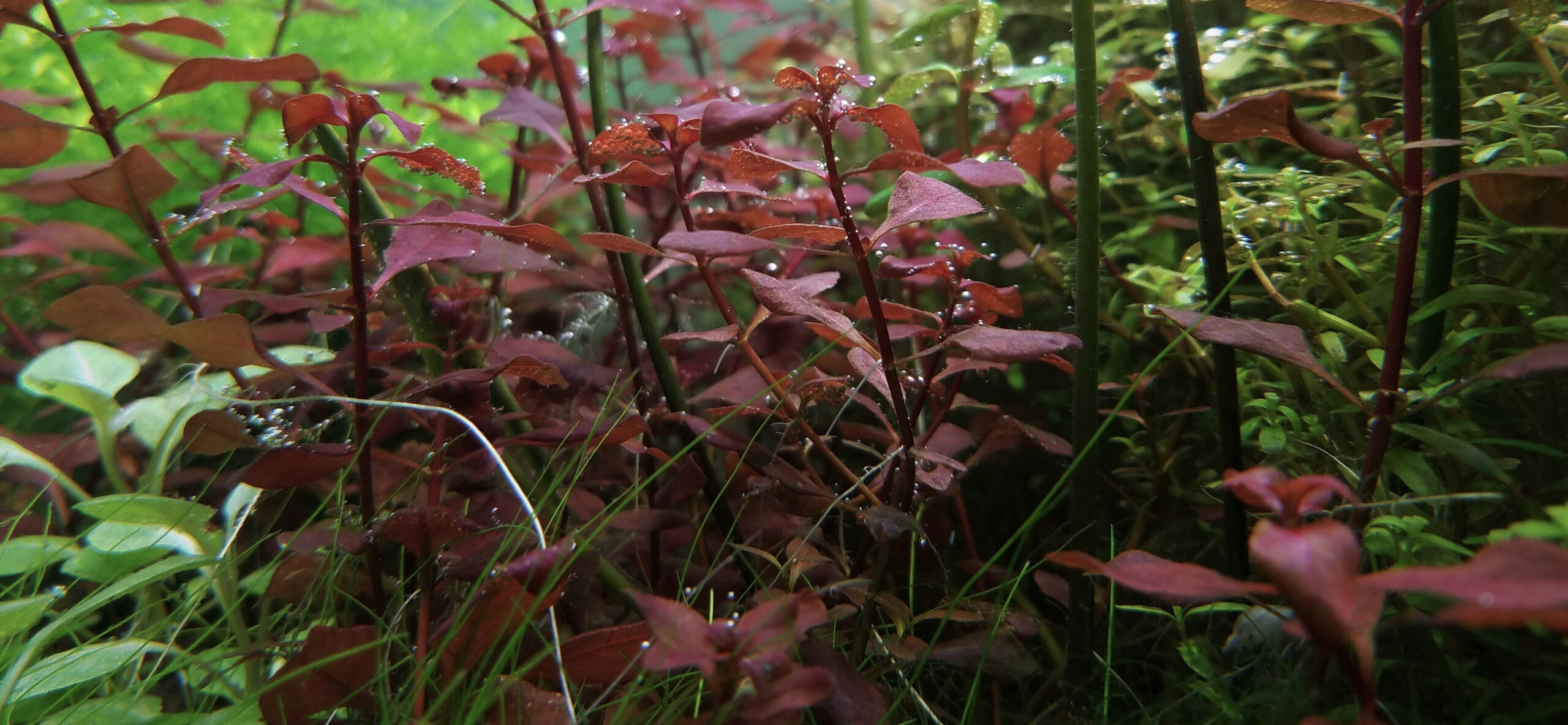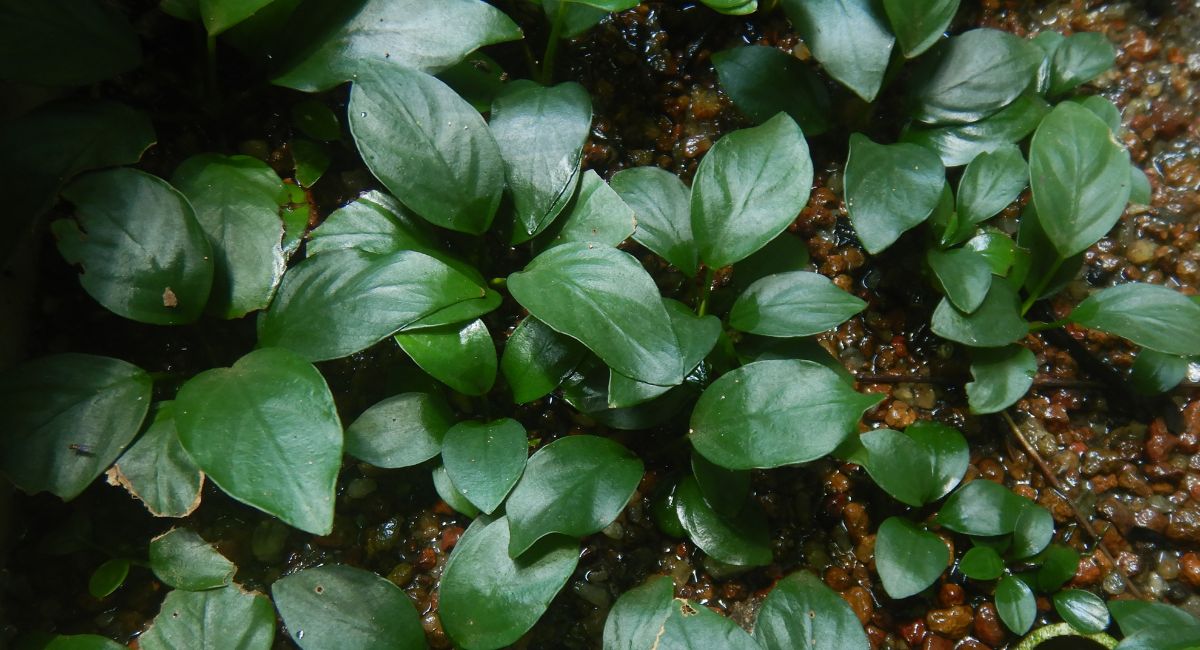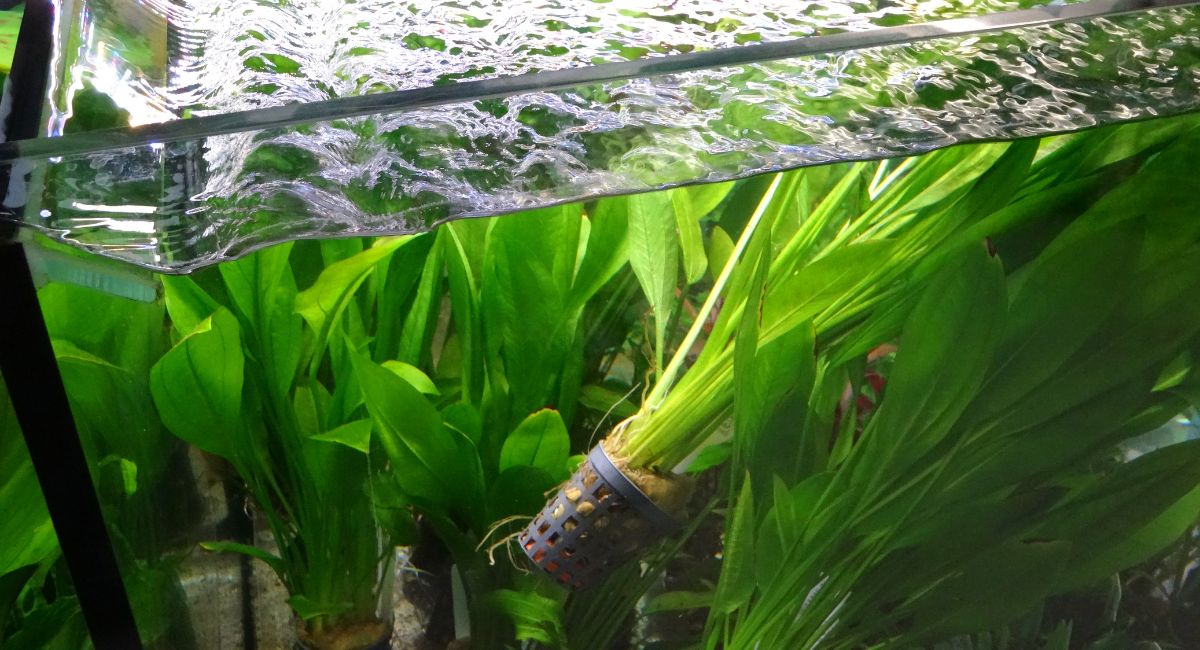Smartplantedaquarium.com participates in affiliate marketing programs. We may earn commissions on purchases made through our affiliate links. This doesn't affect our content or recommendations and we only recommend products we would put in our own tanks.
The Amazon Frogbit, also known as smooth frogbit or West Indian spongeplant, thrives in the calm, slow-moving waters of its natural habitat. Its heart-shaped leaves and delicate, feathery roots create a picturesque scene on the water’s surface, adding a touch of elegance to any aquarium landscape. Unlike rooted plants, the Amazon Frogbit floats effortlessly, making it a unique and visually appealing addition.
Adding this plant to your aquarium comes with a plethora of benefits. Firstly, its floating nature means it won’t require a specific substrate or potting, making it a hassle-free choice for beginners. Secondly, its ability to rapidly absorb excess nutrients from the water can help maintain water quality and reduce algae growth. Moreover, this floating plant provides excellent shelter and breeding grounds for small aquatic creatures, fostering a natural ecosystem within your aquarium.
The beauty of Smooth Frogbit extends beyond its appearance; it also contributes to the well-being of your aquatic companions. By providing shade on the water’s surface, it helps reduce direct sunlight, preventing excessive heating and reducing stress on your fish and other inhabitants. Additionally, its oxygenating properties support a healthy underwater environment, promoting the vitality of your aquatic life.
Intrigued by this alluring aquatic plant? Let’s delve into the specifics of planting and caring for Amazon Frogbit, ensuring a successful and thriving addition to your aquarium.
Contents
- Overview of Amazon Frogbit
- Origin and Habitat of Amazon Frogbit
- Description of Amazon Frogbit
- Benefits of Amazon Frogbit for Aquarium
- Water Parameters and Tank Requirements
- Planting Amazon Frogbit
- Propagation of Amazon Frogbit
- Care & Maintenance of Amazon Frogbit
- Common Health Issues And Treatment
- Amazon Frogbit & Tankmates
- Conclusion
- Frequently Asked Questions
Overview of Amazon Frogbit
Amazon Frogbit, scientifically known as Limnobium laevigatum, is a captivating floating aquatic plant native to the Amazon River basin. With its heart-shaped leaves and delicate roots, it adds an enchanting touch to any aquarium landscape. This easy-to-grow plant is an excellent choice for both beginners and experienced aquarists.
| Attribute | Description |
|---|---|
| Scientific Name | Limnobium laevigatum |
| Common Name | Amazon Frogbit |
| Origin | Native to the Amazon River basin |
| Difficulty Level | Easy to grow |
| Light Requirement | Low to medium |
| Water Conditions | pH: 6.0 – 7.5, Soft to moderately hard water |
| Best Temperature | 68°F – 82°F (20°C – 28°C) |
| Substrate | Not required, as it’s a floating plant |
| Position in Tank | Floating on the water’s surface, often as a background plant |
| Growth Rate | Moderate |
| Maximum Size | 2-4 inches in diameter (5-10 cm) |
| Compatible Plants | Anubias, Java Fern, Water Lettuce, Water Hyacinth, Hornwort |
| Ideal Tank Mates | Peaceful community fish such as Tetras, Guppies, Corydoras, and Dwarf Gouramis |
| Feeding and Nutrients | Extracts nutrients from the water column; no additional feeding required |
| Maintenance and Care | Minimal maintenance; remove any excess growth to prevent overcrowding |
| Propagation | Reproduces through daughter plants (runners) which can be separated and replanted |
Origin and Habitat of Amazon Frogbit
Amazon Frogbit (Limnobium laevigatum) is a floating freshwater plant native to the Amazon Basin, which spans across several countries in South America.
It is found in freshwater habitats such as ponds, lakes, and slow-moving rivers. It prefers calm waters where it can spread out its rosette of leaves on the water’s surface. The plant’s natural habitat is characterized by warm temperatures and tropical conditions. It prefers calm, slow-moving, or stagnant water bodies and is often found in ponds, lakes, and slow-moving rivers.
In recent times, the Amazon Frogbit has been introduced to other parts of the world, both intentionally for aquarium and pond decoration and unintentionally as an invasive species. In some areas where it’s not native, it can outcompete native plants and alter local ecosystems.
Description of Amazon Frogbit
The Amazon Frogbit (Limnobium laevigatum) is a species of aquatic, floating plant, notable for its rosette of leaves that float on the water’s surface.
- Leaves: The leaves of the Amazon Frogbit are light green, round to elliptical in shape, and are generally 1 to 2 cm in diameter, although they can grow larger in optimal conditions. They have a waxy upper surface that repels water and helps in floating.
- Roots: The plant has long, feathery, fibrous roots that dangle in the water. These roots do not anchor into the substrate but absorb nutrients directly from the water, acting as a nutrient sink. They also provide habitat for aquatic fauna like fish and invertebrates.
- Flowers: Amazon Frogbit produces small, white flowers. The flowers are hermaphroditic, having both male and female organs, and are pollinated by flies. However, flowering is relatively rare, especially in aquarium conditions.
- Aquarium Use: Amazon Frogbit is popular in the aquarium trade due to its attractive appearance and its ability to provide shelter for aquatic animals. It is valued for its ability to reduce nitrogen levels in the water and its proficiency in out-competing algae for nutrients, thus helping in algae control.
- Invasive Potential: The rapid and prolific growth of Amazon Frogbit can lead to it becoming invasive in non-native areas, outcompeting native aquatic plants and affecting local ecosystems.
Benefits of Amazon Frogbit for Aquarium
Amazon Frogbit serves as a highly beneficial addition to aquariums. Its aesthetically pleasing appearance, with its rosette of floating leaves, enriches the visual appeal of aquariums. Beyond aesthetics, it offers functional advantages by providing shelter and a sense of security to aquatic animals, especially small fish and invertebrates, creating a more hospitable and enriched environment for them.
The long, feathery roots of the Frogbit are essential in offering additional areas for fish to explore and for beneficial bacteria to colonize, aiding in the biological filtration of the aquarium water.
Furthermore, Amazon Frogbit is renowned for its remarkable ability to purify water. It absorbs nutrients, particularly nitrates and phosphates, directly from the water, acting as a nutrient sink.
This nutrient absorption capability is pivotal in controlling algae growth, as it reduces the nutrients available for algae, thereby maintaining a balanced and healthy aquarium ecosystem. By reducing the levels of nitrogenous waste, it contributes to the overall health and well-being of the aquarium inhabitants.
Moreover, the floating leaves of Amazon Frogbit reduce the amount of light penetrating the water, which can be beneficial in controlling the growth of undesirable algae and in creating shaded areas, catering to the preferences of certain aquatic species.
For hobbyists looking to establish a well-balanced, visually appealing, and healthy aquarium, incorporating Amazon Frogbit can be an excellent choice. However, care should be taken to manage its growth to prevent it from covering the entire water surface and impacting the availability of light to other aquatic plants in the aquarium.
Water Parameters and Tank Requirements
Amazon Frogbit is quite adaptable but thrives best in specific water conditions and with particular tank requirements.
Water Parameters:
- pH Level: Amazon Frogbit prefers slightly acidic to neutral water, with a pH range of 6.0 to 7.5.
- Temperature: Being a tropical plant, it thrives in warmer temperatures, ideally between 18°C to 30°C (64°F to 86°F).
- Water Hardness: It does well in soft to moderately hard water, with a general hardness (GH) of 3 to 12 dGH.
- Lighting: Amazon Frogbit requires moderate to high lighting to sustain its growth. However, it can adapt to lower light conditions.
Tank Requirements:
- Tank Size: Amazon Frogbit can be kept in a variety of tank sizes but should be proportionally adequate, considering the plant’s growth rate and size. A larger tank will accommodate its prolific growth better.
- Filtration: A gentle filter is recommended as strong water current can damage the leaves. Sponge filters or baffled outlets are ideal to reduce water flow.
- Maintenance: Regular removal of older, yellowing leaves and controlling the plant’s coverage on the water surface is crucial to avoid complete shading of the tank and to allow light to reach submerged plants.
- Nutrient Supply: While Amazon Frogbit absorbs nutrients from the water, supplementing with a balanced liquid fertilizer can promote healthier growth, especially in tanks with low nutrient levels.
- Substrate: Substrate is not a requirement for Amazon Frogbit as it does not root in the substrate but floats on the water’s surface.
- Inhabitants: It is suitable for tanks with a variety of fish, especially those that prefer shaded areas. However, large, herbivorous fish may damage the plant by feeding on its leaves.
Additional Considerations:
- Placement: It is essential to ensure that the floating leaves of the Amazon Frogbit do not get wet as this can lead to rot. Placement away from splashes and disturbances is ideal.
- Invasive Control: Regular trimming and removal of excess plants are necessary, especially in outdoor ponds, to control its growth and prevent it from becoming invasive.
- Quarantine: Before adding Amazon Frogbit to an established tank, it is wise to quarantine the plant to observe for any signs of pests or diseases.
Planting Amazon Frogbit
Planting Amazon Frogbit is relatively straightforward, as it is a floating plant and doesn’t require anchoring in substrate like many other aquarium plants. Below are the steps for “planting” or introducing Amazon Frogbit into your aquarium:
Quarantine: Before introducing Amazon Frogbit into your aquarium, it is advisable to quarantine the plant for a few days to a couple of weeks to observe for any pests, diseases, or hitchhikers that could potentially harm the existing aquarium ecosystem.
Acclimatization: Gradually acclimate the Amazon Frogbit to the water parameters of your aquarium. You can do this by placing the plant in a container with its original water and slowly adding small amounts of your aquarium water to it over time until it is fully acclimated.
Introduction: Once acclimatized, gently place the Amazon Frogbit on the surface of the water in your aquarium. Avoid submerging the leaves, as this can lead to rot. Ensure that the leaves are dry and above the water surface, and that the roots are dangling in the water.
Positioning: Arrange the plant in areas with less water movement to avoid damage to the leaves. If your aquarium has a high flow rate, consider using a floating ring or a barrier to keep the Frogbit in calmer waters. Ensure that the plant is placed away from splashes and water disturbances, and avoid placing it directly under a filter outlet.
Maintenance: Regularly remove any dead or yellowing leaves to maintain the health of the plant and the aquarium. Manage the coverage of Amazon Frogbit on the water surface to ensure that it doesn’t cover the entire surface area, which could block light to the submerged plants and disrupt the gas exchange at the water surface.
Nutrient Supply: Although Amazon Frogbit will absorb nutrients from the water, you can supplement its growth with a balanced, liquid aquatic plant fertilizer, especially if the nutrient levels in your tank are low.
Important Considerations
- Lighting: Ensure that the aquarium receives adequate lighting as Amazon Frogbit requires moderate to high light levels to thrive.
- Space Management: Regularly thin out the Amazon Frogbit to avoid overcrowding and to allow light to reach other plants in the aquarium.
- Monitoring: Keep an eye on the plant’s growth and overall health, and address any issues like nutrient deficiencies or pest infestations promptly.
Propagation of Amazon Frogbit
Amazon Frogbit (Limnobium laevigatum) mainly propagates through a vegetative method known as “offsetting,” where daughter plants form on the mother plant and eventually separate. Here’s how the propagation generally occurs:
Healthy Parent Plant: Start with a healthy, mature Amazon Frogbit as the parent plant. Healthy plants are more likely to produce more daughter plants.
Formation of Daughter Plants: The parent plant will naturally produce daughter plants or offsets from its stolons (horizontal stems). These daughter plants will start developing their leaves and roots while attached to the parent plant.
Separation: Once the daughter plants have developed sufficient roots and leaves, they will naturally detach from the parent plant and float away, becoming independent plants. If desired, you can manually separate the daughter plants from the parent plant once they have developed a few leaves and roots, ensuring not to damage the stems and roots during separation.
Growth and Development: After separation, the daughter plants will continue to grow and develop on their own, eventually becoming mature plants capable of producing their offspring.
Maintenance: Regularly remove unhealthy or yellowing leaves and manage the plant density to maintain optimum health and encourage more growth and propagation.
Managing Rapid Propagation: Amazon Frogbit can propagate rapidly and may cover the water surface quickly, blocking light to submerged plants and affecting gas exchange. Regularly removing excess plants and managing the coverage can help in maintaining a balanced and healthy aquarium environment.
Additional Considerations:
- Nutrient Supply: To encourage propagation, ensure that the water contains sufficient nutrients. If needed, add a balanced liquid fertilizer to supplement the nutrient levels in the water.
- Lighting: Maintain adequate lighting levels, as Amazon Frogbit requires moderate to high light for optimal growth and propagation.
- Water Quality: Maintain good water quality with appropriate pH, temperature, and hardness levels, and keep ammonia, nitrites, and nitrates in check.
- Density Management: Regularly thin out the Amazon Frogbit to prevent overcrowding and to allow light to reach other aquatic plants in the aquarium.
Care & Maintenance of Amazon Frogbit
Caring for and maintaining Amazon Frogbit in an aquarium ensures that it remains healthy and continues to contribute positively to the aquarium ecosystem. Here are some guidelines and tips for the care and maintenance of Amazon Frogbit:
Protection from Water Movement: Amazon Frogbit is sensitive to excessive water movement, which can damage its leaves. Consider installing barriers or using floating rings to create a calm area for the Frogbit, especially in aquariums with high water flow.
Avoiding Waterlogged Leaves: Ensuring that the leaves of the Frogbit do not get submerged or excessively wet is crucial to prevent rotting. Place it carefully on the water surface, and ensure splashes from filter outlets or air stones do not wet the leaves.
Regular Inspection: Regularly inspect the Amazon Frogbit for signs of pests, diseases, or nutrient deficiencies. Addressing these issues promptly can prevent them from affecting the overall health of the plant and the aquarium.
Pruning: Periodic pruning can help maintain the aesthetics and health of the Amazon Frogbit. Removing overgrown, unhealthy, or damaged parts can encourage more vigorous growth and reduce the risk of diseases.
Balancing Light Availability: Monitor the light availability for submerged plants in the aquarium. If the Frogbit is shading them excessively, consider using aquarium lighting with higher intensity or adjusting the placement of lights to ensure all plants receive adequate light.
Monitoring Growth: Keep a close eye on the growth rate of Amazon Frogbit. If it is growing too fast and covering the water surface extensively, consider reducing nutrient availability or adjusting light conditions to slow its growth rate.
Water Quality: Regular water changes and maintaining stable water parameters are essential for the well-being of Amazon Frogbit. Avoid drastic changes in water conditions, as this can stress the plant.
Temperature Fluctuations: Protect Amazon Frogbit from extreme temperature fluctuations. While it can tolerate a range of temperatures, sudden changes can be detrimental to its health.
Common Health Issues And Treatment
Amazon Frogbit is generally a robust and hardy plant, but it can experience a few health issues due to suboptimal conditions or external factors. Here are some common health issues and their respective treatments:
Leaf Rot: The leaves of Amazon Frogbit may rot if they remain submerged or excessively wet. Remove the affected leaves and ensure that the remaining leaves stay dry and above the water surface. Adjust the water flow and placement to avoid splashes on the leaves.
Nutrient Deficiencies: Yellowing leaves or stunted growth can indicate a lack of essential nutrients. Supplement with a balanced liquid fertilizer that includes essential micro and macronutrients. Regularly monitor nutrient levels in the water to maintain optimal conditions.
Pest Infestation: Pests like aphids and spider mites can infest Amazon Frogbit and damage the leaves. Remove visibly infested leaves and treat the plant with a suitable pesticide or insecticidal soap that is safe for aquatic environments. Quarantine new plants before adding them to the aquarium to prevent introducing pests.
Inadequate Lighting: Leggy growth and smaller, spaced-out leaves can be signs of insufficient light. Increase the light intensity or duration and ensure that the light reaches the Frogbit by managing its density on the water surface.
Poor Water Quality: Poor water quality can lead to weakened plants, making them more susceptible to diseases and pests. Regular water changes, appropriate filtration, and maintaining stable water parameters can enhance water quality and plant health.
Overcrowding: Dense growth can lead to competition for light and nutrients, affecting the health of individual plants. Regularly thin out the Amazon Frogbit to manage density and ensure each plant receives adequate light and nutrients.
Temperature Stress: Exposure to temperatures outside the preferred range can stress the plant and lead to weakened growth. Maintain the aquarium temperature within the preferred range of 18°C to 30°C (64°F to 86°F) and avoid sudden fluctuations.
Algae Growth: Algae can grow on the leaves of Amazon Frogbit, competing for nutrients and light. Manage nutrient levels and light availability in the aquarium to control algae growth. Remove algae manually from leaves if needed.
Amazon Frogbit & Tankmates
Amazon Frogbit can be a harmonious addition to a diverse range of aquariums and can coexist well with various tankmates, including fish, invertebrates, and other plants. However, some considerations need to be made when selecting tankmates for Amazon Frogbit.
Suitable Tankmates
Small to Medium-sized Fish: Amazon Frogbit is suitable for tanks with small to medium-sized, non-aggressive fish that do not have a tendency to eat or damage plants. Examples include Guppies, Tetras, and Rasboras.
Shrimp and Snails: Invertebrates like shrimp and snails are generally good companions for Amazon Frogbit. Shrimp, especially, benefit from the cover and the additional feeding grounds provided by the roots of Amazon Frogbit.
Bettas: Bettas often appreciate the shelter provided by floating plants like Amazon Frogbit, and the plant can create a more enriched environment for them.
Submerged Plants: Submerged plants that do not require high light levels can coexist well with Amazon Frogbit. Consider choosing plants that can thrive in shaded conditions due to the potential light blockage by the dense growth of Frogbit.
Considerations for Tankmates
Herbivorous Fish: Larger, herbivorous fish that have a tendency to eat or uproot plants should be avoided as they may damage or consume Amazon Frogbit.
High Light Requiring Plants: Amazon Frogbit can block light to submerged plants. Therefore, it might not be the best companion for plants that have high light requirements unless lighting is adequately managed.
Aggressive Fish: Highly territorial or aggressive fish may disturb the Amazon Frogbit or damage it during displays of aggression or territorial disputes.
Overcrowding: Overcrowding with too many tankmates can lead to competition for resources and may impact the health of Amazon Frogbit due to increased waste and nutrient levels in the water.
Conclusion
Amazon Frogbit (Limnobium laevigatum) is a versatile and attractive aquatic plant that can enhance the beauty and ecological balance of your aquarium or pond. With its floating nature, lily-pad-like leaves, and delicate roots, Amazon Frogbit adds a touch of elegance and natural charm to any aquatic setting.
Whether you’re a beginner or an experienced hobbyist, Amazon Frogbit offers several benefits. It is relatively easy to care for, adaptable to various water parameters and can thrive in different lighting conditions. Its floating growth habit contributes to oxygenation, natural filtration, and shade for aquatic inhabitants.
By following proper planting methods, maintaining suitable water conditions, providing adequate lighting, and controlling its growth, you can enjoy the rapid growth and lush appearance of Amazon Frogbit in your aquatic environment. Regular maintenance, including thinning out excess growth and monitoring for pests, helps ensure the plant’s health and prevents overcrowding.
Frequently Asked Questions
1. How fast does Amazon Frogbit grow?
Amazon Frogbit exhibits a moderate growth rate, and under optimal conditions, it can grow several inches in diameter within a few weeks. Regular pruning and thinning are essential to prevent excessive growth and maintain a well-balanced aquatic environment.
2. How big does Amazon Frogbit grow?
The average size of Amazon Frogbit ranges from 2 to 4 inches (5 to 10 cm) in diameter. However, in favorable conditions, some specimens can grow even larger, creating an impressive and eye-catching sight on the water’s surface.
3. What is the growth pattern of Amazon Frogbit?
Amazon Frogbit displays a floating growth pattern, gracefully drifting on the water’s surface. Its heart-shaped leaves and feathery roots create an enchanting spectacle, providing shade and shelter to the aquatic life below.
4. Is Amazon Frogbit suitable for beginners?
Yes, Amazon Frogbit is an excellent choice for beginners in the world of aquarium plants. Its easy-care nature and low-maintenance requirements make it an ideal starting point for those new to aquascaping. Its floating growth pattern eliminates the need for substrate, simplifying the planting process.
5. Is Amazon Frogbit suitable for a low-tech aquarium?
Yes, Amazon Frogbit thrives in low-tech aquarium setups, making it an ideal choice for those who prefer a simpler, more natural approach to fish-keeping. With minimal lighting and basic water care, this floating plant will flourish, enhancing the beauty and ecological balance of your low-tech aquarium.
